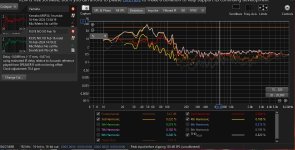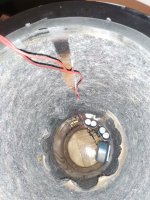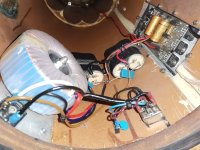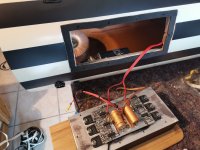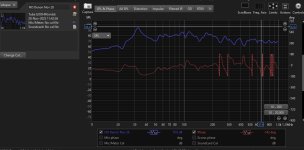Dears,
This is my first tread here after introduction. I would like to present and discuss ongoing project with Visaton B80 wide-range and 10" woofer in particular cabinets.
As mentioned in my introduction, knowledge, experience and innovations of members on this forum is mighty impressive, I hope you can help me to bring this project to the end.
I call it Beetlejuce as my wife asked me to paint stripes at the end of the project. Initially I wanted to call it "i" as it resembles the letter i. It also reminds me a lot of cult the Residents album the King and Eye
However, finally its Beetlejuice, the wide-range orb I call Eye, and the woofer the Tube.

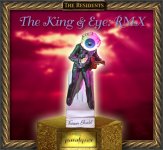
This is my first tread here after introduction. I would like to present and discuss ongoing project with Visaton B80 wide-range and 10" woofer in particular cabinets.
As mentioned in my introduction, knowledge, experience and innovations of members on this forum is mighty impressive, I hope you can help me to bring this project to the end.
I call it Beetlejuce as my wife asked me to paint stripes at the end of the project. Initially I wanted to call it "i" as it resembles the letter i. It also reminds me a lot of cult the Residents album the King and Eye
However, finally its Beetlejuice, the wide-range orb I call Eye, and the woofer the Tube.

Last edited by a moderator:
The Eye is in cooking soon after this Visaton driver was released. Soon I bought a pair and started to build, however this ended in a box and revitalized only last year.
The Eye is many times described Ikea salad bowl speaker from Ikea Blanda bowls so I will not discuss much about construction except one tip where I did mistake and spent hours repairing it.
Don't glue 2 bowls together before you completely prepare fitting for the driver. The salad bowls are not that thick and there will be no space to anchor mounting screws. Further, these small drivers have very little space left for mistakes and its difficult to make it right without special mounting piece.
Instead, I recommend to make an mounting piece, shape of doughnut with outer diameter just as the size of driver or little bit bigger. Ideally this can be turned on lathe from block of aluminum if you can. Hard plastic will be fine (check if your glue sticks to your plastic) or block of solid hard wood. I would not use ply or any composite or soft wood as the dimensions and strength are both critical.
Only when speaker fits perfectly in Doughnut , glue it in salad bowl (needles to say that routed hole in salad bowl should match doughnut. Only then you can glue 2 bawls together.
On attached picture is rough sketch

The Eye is many times described Ikea salad bowl speaker from Ikea Blanda bowls so I will not discuss much about construction except one tip where I did mistake and spent hours repairing it.
Don't glue 2 bowls together before you completely prepare fitting for the driver. The salad bowls are not that thick and there will be no space to anchor mounting screws. Further, these small drivers have very little space left for mistakes and its difficult to make it right without special mounting piece.
Instead, I recommend to make an mounting piece, shape of doughnut with outer diameter just as the size of driver or little bit bigger. Ideally this can be turned on lathe from block of aluminum if you can. Hard plastic will be fine (check if your glue sticks to your plastic) or block of solid hard wood. I would not use ply or any composite or soft wood as the dimensions and strength are both critical.
Only when speaker fits perfectly in Doughnut , glue it in salad bowl (needles to say that routed hole in salad bowl should match doughnut. Only then you can glue 2 bawls together.
On attached picture is rough sketch
Last edited by a moderator:
Listening and measuring of the Eyes.
When first Eyes were made, I could not resist to listen to them as they are, full range without XO. My other speakers are Sonus Faber Signum and Yamaha MSP5A near field monitors. The eyes blow away both instantly, particularly sound stage is so much larger and cleaner, mids without comparison.
Bass was of course mediocre, especially compared with Fabers, but that's expected.
I have cheap Omnitronic MM -2 USB microfone for measurement, below are pictures of Eye and Yamaha response comparison measured in room at as much as possible same location. Second 2 pictures are distortion graphs of both. Note distortion in mid range of the Eye.
I can only but recommend making Eye as stand alone nearfield , but then I would consider adding bass reflex, not for adding bass but to release driver from stress. Elliot sound products has good article on this: https://www.sound-au.com/qb5align.htm
Also to recommend is this nice Italian site where good people posted numbers of drive measurement and comparisons to OEM datasheets. Think its very useful when deciding what driver to choose: https://www.dibirama.altervista.org...n-b80-8-extended-range-3-3-8-ohm-50-wmax.html
When first Eyes were made, I could not resist to listen to them as they are, full range without XO. My other speakers are Sonus Faber Signum and Yamaha MSP5A near field monitors. The eyes blow away both instantly, particularly sound stage is so much larger and cleaner, mids without comparison.
Bass was of course mediocre, especially compared with Fabers, but that's expected.
I have cheap Omnitronic MM -2 USB microfone for measurement, below are pictures of Eye and Yamaha response comparison measured in room at as much as possible same location. Second 2 pictures are distortion graphs of both. Note distortion in mid range of the Eye.
I can only but recommend making Eye as stand alone nearfield , but then I would consider adding bass reflex, not for adding bass but to release driver from stress. Elliot sound products has good article on this: https://www.sound-au.com/qb5align.htm
Also to recommend is this nice Italian site where good people posted numbers of drive measurement and comparisons to OEM datasheets. Think its very useful when deciding what driver to choose: https://www.dibirama.altervista.org...n-b80-8-extended-range-3-3-8-ohm-50-wmax.html
Attachments
The Tubes begun their life much earlier. I built them in ancient times, 1993 or 1994 from 300mm PVC sewage pipes, they are 30 years with me. There was no Internet then, no measuring tools, no simulation and definetly no tubular speakers projects, just some magazines.
I liked this idea as it will not resonate and moving mass of the woofer will fight the floor and own weight when working. Today there is whole science developed about SonoSub
The first use of these was as bandpass sub with Kef B200G inside. Older people will remember that bandpass was in big fashion then, remember KEF reference speakers from that era?
10 years down the road Sonus Fabers came to my house and KEF's went to garage.
Fabers are small and I wanted to make subs for them; I remodeled Tubes completely; closed bandpass hole, opened the top to fit the driver and installed 200W amplifier inside. The idea was to buy Seas Excell W26FX and put it in sealed enclosure with Linkwitz transform circuit. That's why I put 200W in as I thought it would be needed for this set up.
Unfortunately an seller from German shop that I will not mention, persuaded me to buy something else, Alcone SW 10 (attached datasheet). He said its cheaper and better, me with little experience believed! I could not get any decent bass with this and the whole thing ended in garage for another 10 years.
PS, short on construction, its double wall pipe and to make it following steps can be taken:
I liked this idea as it will not resonate and moving mass of the woofer will fight the floor and own weight when working. Today there is whole science developed about SonoSub
The first use of these was as bandpass sub with Kef B200G inside. Older people will remember that bandpass was in big fashion then, remember KEF reference speakers from that era?
10 years down the road Sonus Fabers came to my house and KEF's went to garage.
Fabers are small and I wanted to make subs for them; I remodeled Tubes completely; closed bandpass hole, opened the top to fit the driver and installed 200W amplifier inside. The idea was to buy Seas Excell W26FX and put it in sealed enclosure with Linkwitz transform circuit. That's why I put 200W in as I thought it would be needed for this set up.
Unfortunately an seller from German shop that I will not mention, persuaded me to buy something else, Alcone SW 10 (attached datasheet). He said its cheaper and better, me with little experience believed! I could not get any decent bass with this and the whole thing ended in garage for another 10 years.
PS, short on construction, its double wall pipe and to make it following steps can be taken:
- Cut one pipe on desired length
- prepare 3 circles from thick MDF or material of your choice. Diameter must tightly fit inner diameter of the tube.
- in one circle cut and prepare holes for mounting driver
- cut big hole in second circle, that will be just mounting , fixing ring for last circle
- install bass reflex tube in the last circle
- cut second tube on length which is for 3 circles thickness less than the first tube
- cut approx 15 mm straight cut along this second tube
- this second tube can be now squeezed and inserted inside the outer tube. Check if everything fit dry without glue, sliced tube inside and 3 circles fitting inside.
- If all is fine, take it apart and apply glue than fit it all together again... That's all.
- Before you start gluing, check that particular glue works with PVC pipes as many don't, at the time I used Sixaflex 221 I think. Also good to use very long setting time glue as there will be no repairs when this sets.
Attachments
Present Tube:
Now I finally restarted this hobby, armed with fantastic articles from here and elsewhere and new simulation and measurement tools life is so much easier today.
Quickly realized that this driver with extremely low Q has nothing to do with sealed box, and modified whole thing again.
I started with 90mm sewage pipe for bass reflex, result was horrible whoops and puffs. Ended with 130mm sewage tube and it is much better. The reflex pipe I managed to flare with heat gun and piece of steel pipe. I carpeted inside and filled with fiberglass wool.
On the pictures you will see whole thing inside as well as measurement of only tube without XO (positioned in a corner):
Now I finally restarted this hobby, armed with fantastic articles from here and elsewhere and new simulation and measurement tools life is so much easier today.
Quickly realized that this driver with extremely low Q has nothing to do with sealed box, and modified whole thing again.
I started with 90mm sewage pipe for bass reflex, result was horrible whoops and puffs. Ended with 130mm sewage tube and it is much better. The reflex pipe I managed to flare with heat gun and piece of steel pipe. I carpeted inside and filled with fiberglass wool.
On the pictures you will see whole thing inside as well as measurement of only tube without XO (positioned in a corner):
Attachments
Killing Q with series resistor,
WinISD was showing me much better simulation results if I add resistance in series with speaker and that way increase low Qts of only 0.23 + kill any damping factor. I tried with slowly increasing resistance (from 0 to 5.2 Ohm in 0.68 ohm increments and nothing fantastic happened despises simulator showing something completely different.. Here is screenshot of those measurements. I left this solution out for the moment and concluded that the measurement and listening are proof of pudding.
PS, I will pause here now and continue with complete Beetlejuice and its measurements soon,
Cheers till then
WinISD was showing me much better simulation results if I add resistance in series with speaker and that way increase low Qts of only 0.23 + kill any damping factor. I tried with slowly increasing resistance (from 0 to 5.2 Ohm in 0.68 ohm increments and nothing fantastic happened despises simulator showing something completely different.. Here is screenshot of those measurements. I left this solution out for the moment and concluded that the measurement and listening are proof of pudding.
PS, I will pause here now and continue with complete Beetlejuice and its measurements soon,
Cheers till then
Attachments
Kool.
Does that leave the driver flush? And you don’t want the back of the driver obscured.
I put a ‘donut” between the bowls since they are not full hemispheres. I used that bit to accomodate the vents.
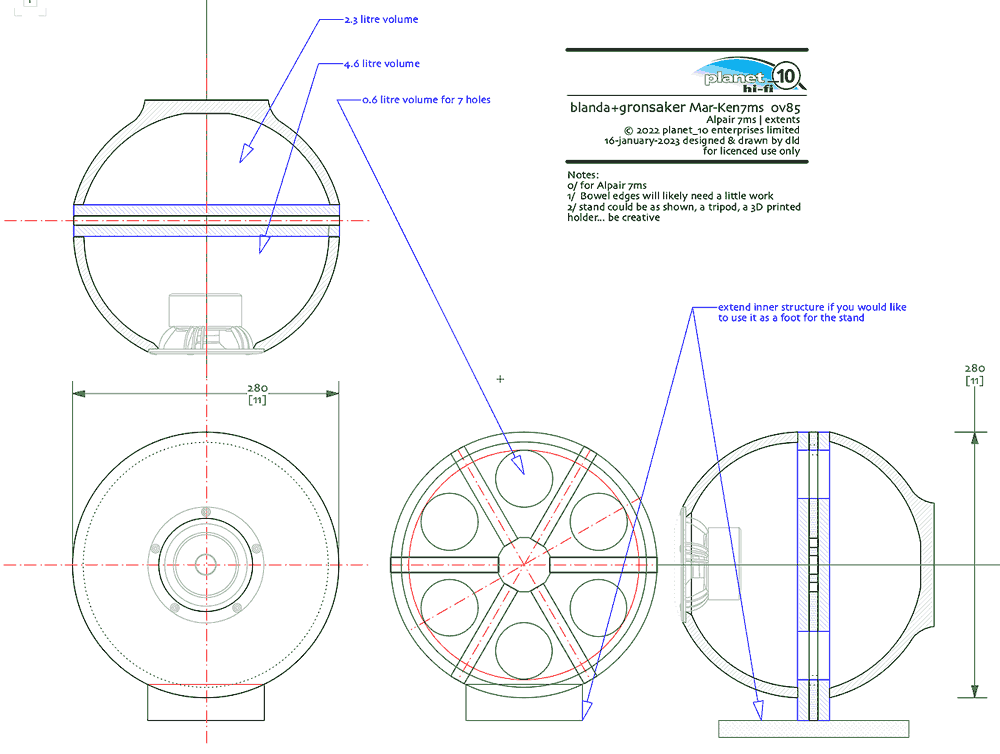
Can you nestle the sphere much closer to the bass driver. Better XO integration. More of a point source.
dave
Instead, I recommend to make an mounting piece, shape of doughnut
Does that leave the driver flush? And you don’t want the back of the driver obscured.
I put a ‘donut” between the bowls since they are not full hemispheres. I used that bit to accomodate the vents.

Can you nestle the sphere much closer to the bass driver. Better XO integration. More of a point source.
dave
Last edited:
Thank you Dave, I was hoping for some comments from people with experience!
My donut has no driver flush, but I rounded back side as much as possible with router, something like on my poor drawing above. If I'll do this again I'll take it to lathe and from aluminum with all good features.
Whoa, you made also dwg of it, congratulations!
I did not even notice that 2 blanda's don't add to sphere 🤔
And yes, I can move them vertically quite easily, mounting is one piece of hardwood rod, it's matter of drilling one new hole. Here is picture, bit hard to see as rod is mat black, deliberately to make it "invisible".
I will try to finish article today, than please recommend how far down would you go.

My donut has no driver flush, but I rounded back side as much as possible with router, something like on my poor drawing above. If I'll do this again I'll take it to lathe and from aluminum with all good features.
Whoa, you made also dwg of it, congratulations!
I did not even notice that 2 blanda's don't add to sphere 🤔
And yes, I can move them vertically quite easily, mounting is one piece of hardwood rod, it's matter of drilling one new hole. Here is picture, bit hard to see as rod is mat black, deliberately to make it "invisible".
I will try to finish article today, than please recommend how far down would you go.
And testing assembled Beetlejuice,
For test set up an DCX2496 is used . Its modified in the way that I took out unbalanced signals after Behringer DAC filter and sent them to 6 gang potentiometer (if someone wants picture of this simple mod pls ask)
Power is from Rotel surround receiver and internal Tube amp disconnected.
The idea is that after the speaker is tuned, I would install 2 amps and analog XO, copy of what is found the best with DCX2496.
The amp that's presently in will go out as its too powerful , woofer is 4 ohm and amp can make 300w in 4 ohm, no sense as B80 can handle 50W peak and I will never reach such high volumes that are possible by woofer with whole system. Instead there will be 2 amps on the same supply rails, just a fact that woofer is 4 ohms will give much more power to bass.
By the way, if someone is interested in amps from post 5 (without heat sinks) , that's BPA-300 built from original National semicon LM3886TF, 6 per channel, so 12 LM3886's all together, pls post me. Its built according to application note without DC servo (0.1% resistors are used for FB) and it has 2 mistakes coming from AN that needs to be corrected, it works as is nevertheless. Chips are original bought in Distrelec - Zurich in 2004 . I also have 4 brand new ones (2 insulated TF and 2 non insulated T) bought at same time - place.
On Behringer, woofer is reduced by -6db and XO frequency is 410Hz on all measurements. I only variate between L-R 24 and BUT6 .
The Omnitronic microphone was placed approx 1m away on Eye level. Speaker was in the corner all the time as on first picture of the post.

For test set up an DCX2496 is used . Its modified in the way that I took out unbalanced signals after Behringer DAC filter and sent them to 6 gang potentiometer (if someone wants picture of this simple mod pls ask)
Power is from Rotel surround receiver and internal Tube amp disconnected.
The idea is that after the speaker is tuned, I would install 2 amps and analog XO, copy of what is found the best with DCX2496.
The amp that's presently in will go out as its too powerful , woofer is 4 ohm and amp can make 300w in 4 ohm, no sense as B80 can handle 50W peak and I will never reach such high volumes that are possible by woofer with whole system. Instead there will be 2 amps on the same supply rails, just a fact that woofer is 4 ohms will give much more power to bass.
By the way, if someone is interested in amps from post 5 (without heat sinks) , that's BPA-300 built from original National semicon LM3886TF, 6 per channel, so 12 LM3886's all together, pls post me. Its built according to application note without DC servo (0.1% resistors are used for FB) and it has 2 mistakes coming from AN that needs to be corrected, it works as is nevertheless. Chips are original bought in Distrelec - Zurich in 2004 . I also have 4 brand new ones (2 insulated TF and 2 non insulated T) bought at same time - place.
On Behringer, woofer is reduced by -6db and XO frequency is 410Hz on all measurements. I only variate between L-R 24 and BUT6 .
The Omnitronic microphone was placed approx 1m away on Eye level. Speaker was in the corner all the time as on first picture of the post.
Here are the graphs,
First of all, I'm quite an rookie in making this. Please see if my graphs are correctly done at all?
First graph is frequency response of 1st (red) and 4th (green) order XO

Huge bumps under 200HZ must be wall reflections (or microphone) as I measured completely different speakers in same place (post #3 above) and curves in bass are almost identical?
Here are Spectrogram and waterfall with 1st order XO , have no idea what is big bump after 10khz, in all other measurements it was clean area. These graphs with 4th order look similar, so I did not attach.


Here is Group delay, 1st order red and 4th order green


First of all, I'm quite an rookie in making this. Please see if my graphs are correctly done at all?
First graph is frequency response of 1st (red) and 4th (green) order XO
Huge bumps under 200HZ must be wall reflections (or microphone) as I measured completely different speakers in same place (post #3 above) and curves in bass are almost identical?
Here are Spectrogram and waterfall with 1st order XO , have no idea what is big bump after 10khz, in all other measurements it was clean area. These graphs with 4th order look similar, so I did not attach.
Here is Group delay, 1st order red and 4th order green
This is how far I got so far and really kindly asking for advice how to proceed.
I know that this Alcone woofer is not perfect match, but at the moment I don't have few hundred Euros to spent on new 10 inchers.
The bumps and dips in bass response are horrible, that must be room reflections. Shall I take the speaker out in open space and repeat measurements (even I will regret this exercise since I can barely lift one assembled speaker)?
In post #7 above, Dave already kindly advice to move Eyes close to the tube, how much?
I did not calibrate DCX + Rotel for this measurements (as I guess that's couple of orders of magnitude more linear than speakers) . Shall I calibrate and repeat?
Microphone I have nothing to calibrate with
Subjectively, I think that 1st order XO sounds a bit cleaner - better than L-R24, but its rather subtle difference. That is at normal (quiet) listening level. For louder "party" level this might change. Also subjectively, bass is rather prodigious , crisp and deep regardless all those horrible peaks and dips.
Thanks ahead!
I know that this Alcone woofer is not perfect match, but at the moment I don't have few hundred Euros to spent on new 10 inchers.
The bumps and dips in bass response are horrible, that must be room reflections. Shall I take the speaker out in open space and repeat measurements (even I will regret this exercise since I can barely lift one assembled speaker)?
In post #7 above, Dave already kindly advice to move Eyes close to the tube, how much?
I did not calibrate DCX + Rotel for this measurements (as I guess that's couple of orders of magnitude more linear than speakers) . Shall I calibrate and repeat?
Microphone I have nothing to calibrate with
Subjectively, I think that 1st order XO sounds a bit cleaner - better than L-R24, but its rather subtle difference. That is at normal (quiet) listening level. For louder "party" level this might change. Also subjectively, bass is rather prodigious , crisp and deep regardless all those horrible peaks and dips.
Thanks ahead!
The stock analog parts of the DCX suck.
I don’t know what happened to my DCX but i still have the 6 gang pot and all the transfornmers to replace the analog section.
@kevinkr has essentially replaced everything in his except the key digital heart, and by all accounts transforms it into something really useful with really good sonics.
dave
I don’t know what happened to my DCX but i still have the 6 gang pot and all the transfornmers to replace the analog section.
@kevinkr has essentially replaced everything in his except the key digital heart, and by all accounts transforms it into something really useful with really good sonics.
dave
Hi Dave,
Dunno, mine is working quite OK for my ears, also I use it only as speaker tuning tool, not as permanent solution for listening music. These njm 4580 are not such bad opamp ( as many criticise) and the output circuit is nothing but commonly used balanced driver in pro gear. In mine DCX, 4580's are branded COOLaudio, wtf 😊.
I replaced capacitors after opamp 1 (first after dac) just to extend leads so I can take unbalanced signal out to the pot which is 10k log. The signal I use that way is affected by only one 4580.
After some hassle I also didn't bother to add any buffer after pot signal as all of power amps I use for testing have input load of 22k or more. But to add that pot it was necessary to extend dcx for another H1 housing, no space on dcx front panel for extra pot, or for extra RCA's on back panel, here are few photos, it works




Dunno, mine is working quite OK for my ears, also I use it only as speaker tuning tool, not as permanent solution for listening music. These njm 4580 are not such bad opamp ( as many criticise) and the output circuit is nothing but commonly used balanced driver in pro gear. In mine DCX, 4580's are branded COOLaudio, wtf 😊.
I replaced capacitors after opamp 1 (first after dac) just to extend leads so I can take unbalanced signal out to the pot which is 10k log. The signal I use that way is affected by only one 4580.
After some hassle I also didn't bother to add any buffer after pot signal as all of power amps I use for testing have input load of 22k or more. But to add that pot it was necessary to extend dcx for another H1 housing, no space on dcx front panel for extra pot, or for extra RCA's on back panel, here are few photos, it works
Uhhhh, this is mightily elaborated.
Fully agree with PS upgrade, I also have one with parts ready to do it as OEM one is simply out of specs.
For my goal of simple speaker testing tool, do you think this minimally modified dcx of mine is enough?
In house I also have this 10 x more expensive jewel, RME fireface UCX on a loan from a friend (small box next to laptop on left) shall I use this to get better results?
If I'll go that way there will be a lot of software work for me, dcx is so simple to use, RME is not programmed for XO work?
Cheers,
Drazen

Fully agree with PS upgrade, I also have one with parts ready to do it as OEM one is simply out of specs.
For my goal of simple speaker testing tool, do you think this minimally modified dcx of mine is enough?
In house I also have this 10 x more expensive jewel, RME fireface UCX on a loan from a friend (small box next to laptop on left) shall I use this to get better results?
If I'll go that way there will be a lot of software work for me, dcx is so simple to use, RME is not programmed for XO work?
Cheers,
Drazen
I think for your stated purposes your current set up is just fine, mine is 100% in the signal path at all times so needed some help. My system uses horns on mids and highs and the bass bins are diy Onkens with close to 100dB efficiency. I have an ADI-2 PRO FSR BE for analog sources and the subs, and a SHD Studio for control and Dirac.
Hi,
Frankly, I write something here just to bring the post little bit up on newest level in forum .
.
During last week I got only one very practical suggestion from Dave (thanks for that!), sincerely looking forward if I can get more guidance, in my subjective opinion this is cool project, bringing industrial design and sound in one nice package, I would like to bring it to an conclusion, there are few different projects I would present, but don't want to open too many own discussions and clutter, better to finish what is actual than move to next...
Nice (and hobby full) weekend to all,
Dražen
Frankly, I write something here just to bring the post little bit up on newest level in forum
During last week I got only one very practical suggestion from Dave (thanks for that!), sincerely looking forward if I can get more guidance, in my subjective opinion this is cool project, bringing industrial design and sound in one nice package, I would like to bring it to an conclusion, there are few different projects I would present, but don't want to open too many own discussions and clutter, better to finish what is actual than move to next...
Nice (and hobby full) weekend to all,
Dražen
Horn system on top, much lower noise and somewhat more detail. There was also a problem with the AES input with background noise (tones, hiss, and random VLF noise) depending on what source was in use back at the SHD Studio. The Studio AES outputs are not transformer isolated and the input transformer had low CMR. In addition the design of the audio I/O PCB may have contributed to the AES input noise problem.
The Ambs Lab I/O board uses more power than the original which resulted in more heat, the SMPS was also pretty noisy and not as efficient as I would have expected. (The linear supply was actually somewhat more efficient which was a huge surprise.) The big win was reducing heat generation in the DCX chassis. Subjectively speaking it was the least significant change I made.
The Ambs Lab I/O board uses more power than the original which resulted in more heat, the SMPS was also pretty noisy and not as efficient as I would have expected. (The linear supply was actually somewhat more efficient which was a huge surprise.) The big win was reducing heat generation in the DCX chassis. Subjectively speaking it was the least significant change I made.
Last edited:
- Home
- Loudspeakers
- Full Range
- Beetlejuice speakers

